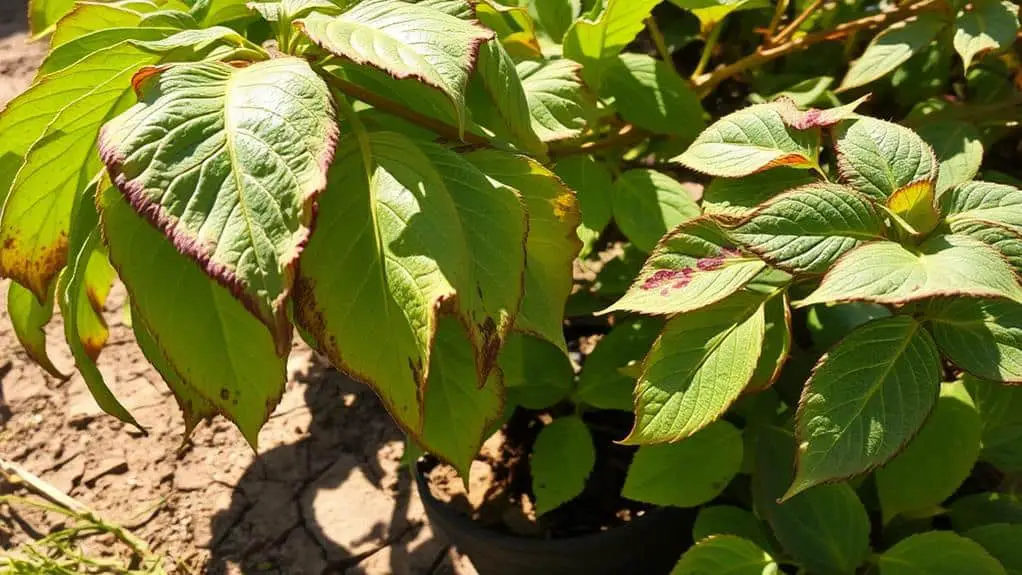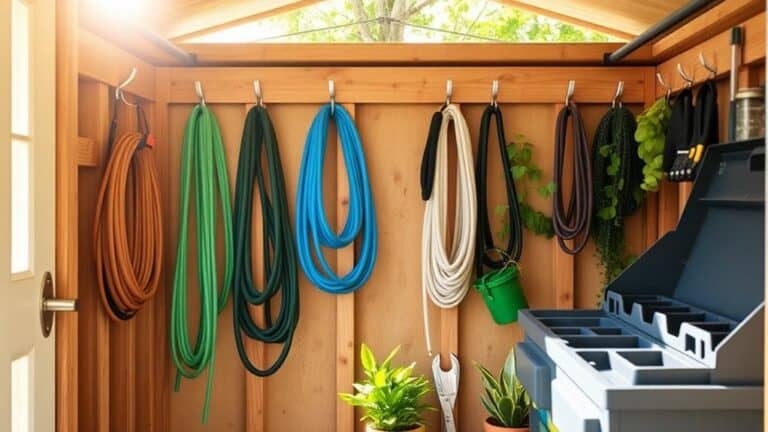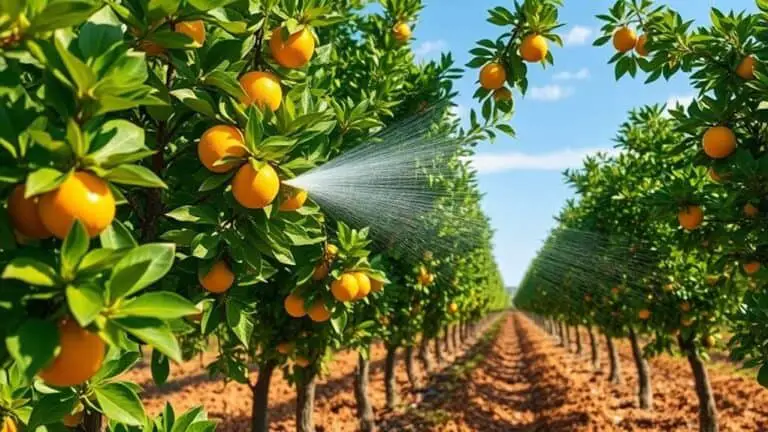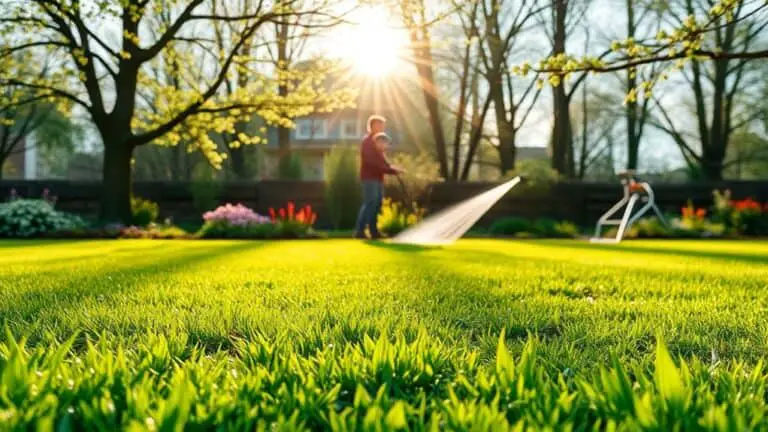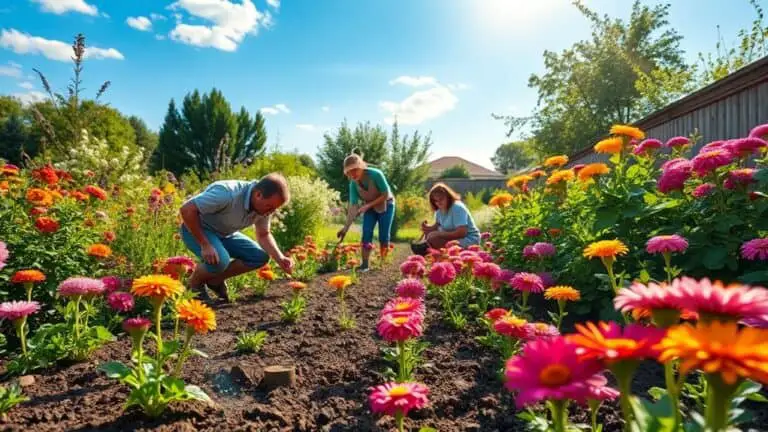Signs Your Plants Are Suffering From Heat Stress
When your plants are suffering from heat stress, they exhibit a range of symptoms that can quickly escalate if not addressed. You'll notice leaf rolling and cupping, signaling that the plants are struggling to retain moisture. Wilting is another common sign, even when the soil appears moist. Dry leaf edges are a clear indicator that the heat is taking a toll. If you don't intervene, you risk blossom and fruit drop, which can severely impact your garden's productivity. Recognizing these symptoms early is vital, but what can you do to help your plants recover?
Leaf Rolling and Cupping
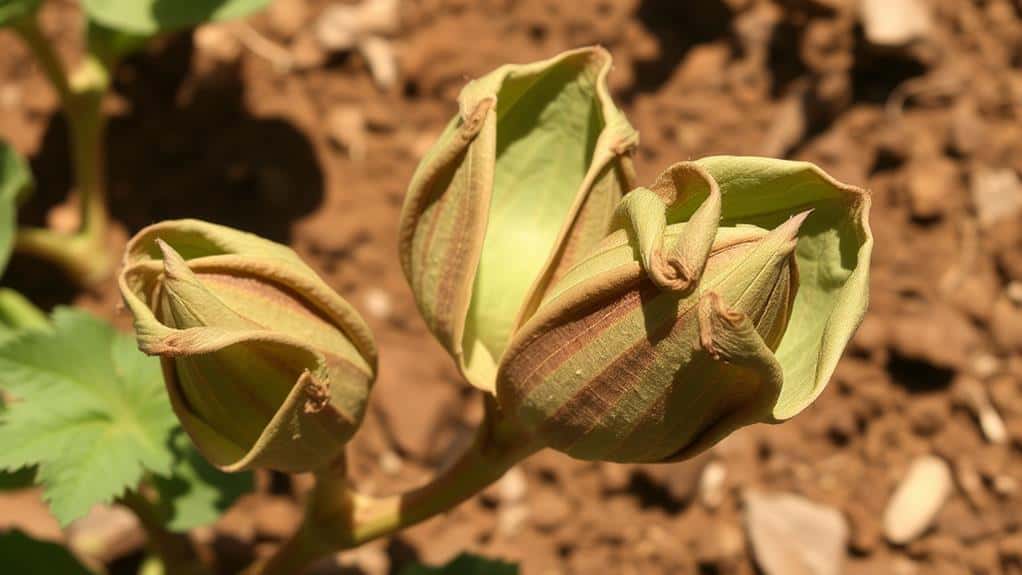
In hot weather, you might notice your plants' leaves rolling and cupping, especially in species like corn and tomatoes. This is a sign of heat stress.
When it gets too hot, plants close their stomata to conserve moisture. This causes the leaves to roll and cup, reducing their surface area and helping the plant cope with the heat.
While this is a natural response, prolonged leaf rolling can indicate severe heat stress and potential damage. You might also see wilting, which means the plant is really struggling to stay hydrated.
Keep an eye on your plants for these signs. If you catch them early, you can take steps to help them survive the heat.
Wilting
Wilting happens when your plants don't get enough water, causing them to lose pressure in their cells. This makes them look droopy and sad, but don't worry—many plants can bounce back quickly with proper care.
To help them recover, check your soil moisture regularly and give your plants a deep drink during hot weather.
Causes of Wilting
When plants wilt, it's often because they're not getting enough moisture, leading to a drop in water pressure within their tissues. Wilting is more common in nonwoody annuals and perennials, which lack the structural support to withstand low moisture levels. Heat stress makes things worse by causing rapid evaporation. If you notice daily wilting that recovers at night, your plants might be going through ongoing heat stress. This signals the need for immediate watering and care adjustments. Regularly monitor soil moisture, especially for shallow-rooted plants, as they dry out faster in hot weather. Prolonged wilting can cause irreversible damage, so staying vigilant is key.
| Cause | Impact | Solution |
|---|---|---|
| Low Moisture | Wilting | Regular Watering |
| High Temperatures | Rapid Evaporation | Mulching and Shading |
| Shallow Root System | Quick Drying | Deep Watering Techniques |
Recovery Tips
Revive your wilting plants by immediately providing them with deep watering to rehydrate their roots and restore turgor pressure.
Make sure you water early in the morning or late in the evening to minimize evaporation, allowing more moisture to reach the roots.
Regularly check soil moisture using a moisture meter or by feeling the soil. If it's dry several inches down, it's time for more watering.
Adding a layer of organic mulch around your plants can help retain soil moisture and reduce temperature fluctuations.
Consider using shade cloth or moving potted plants to shadier areas during peak heat to reduce stress.
With consistent care, you'll help your plants recover and thrive.
Dry Leaf Edges
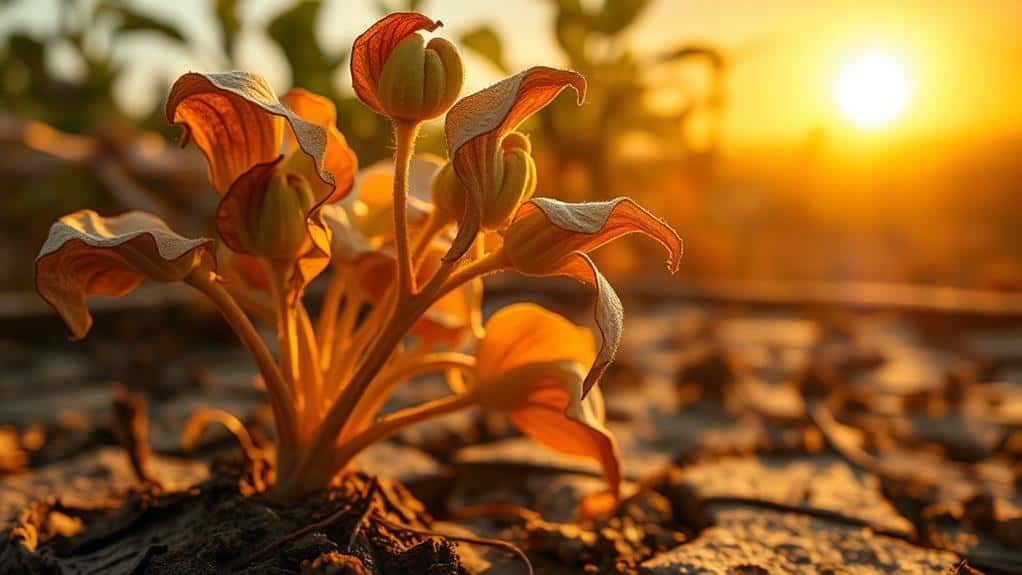
Dry leaf edges are a telltale sign that your plant is suffering from heat stress, often arising when the plant loses moisture faster than it can absorb it due to high temperatures and low humidity.
This is especially common in large-leaved plants like squash. The outer margins dry out while the rest of the leaf remains green.
To help your plant recover, consider these tips:
- Deep watering: Guarantee water reaches the roots.
- Mulching: Keeps soil moist by reducing evaporation.
- Shade cloths: Protects plants from intense sun.
- Morning watering: Reduces water loss during the day.
- Proper spacing: Improves airflow around plants.
Ozone Damage
While dry leaf edges signal heat stress, another significant concern during high temperatures is ozone damage.
When the air quality is poor, plants like tomatoes, cucumbers, squash, and pumpkins can suffer. You might notice bleached and dry patches on leaves, resembling bacterial leaf spot. This cellular damage reduces photosynthesis, weakening plant vigor as leaves can't absorb sunlight effectively.
Prolonged exposure to high ozone levels can severely reduce yields in sensitive crops, especially during heat waves. To protect your plants, monitor air quality and take steps to reduce pollution.
Blossom and Fruit Drop

When plants face extreme heat, they often let go of their blossoms and fruit to survive. This process, known as blossom and fruit drop, is common in heat-sensitive crops like peppers, cucumbers, and squash.
When daytime temperatures exceed 90°F (32°C) for extended periods, plants prioritize conserving resources over reproduction. They close their stomata to reduce water loss, which limits photosynthesis and energy production. This action contributes to the drop of blossoms and fruits.
Fortunately, once temperatures cool, plants can recover and redirect energy back into production.
To identify heat stress in your plants, look for:
- Wilting leaves
- Brown or scorched leaf edges
- Blossom end rot
- Premature fruit drop
- Reduced plant growth
Stay vigilant and support your plants through hot weather!
Watering Strategies
When it comes to watering your plants during heat waves, deep watering is key, ensuring the roots get the 1-2 inches they need each week.
Timing matters too; watering early in the morning helps reduce evaporation, letting plants soak up moisture before the day heats up.
Deep Watering Benefits
Deep watering plays an crucial role in maintaining plant health, especially during periods of heat stress.
By encouraging roots to grow deeper into the soil, deep watering helps plants access essential moisture, making them more resilient. Unlike shallow watering, which only wets the surface, deep watering guarantees water reaches the root zone.
Here are some benefits of deep watering:
- Promotes healthier root growth.
- Reduces the frequency of watering sessions.
- Helps the soil retain moisture longer.
- Minimizes evaporation loss.
- Guarantees water reaches 6-12 inches deep.
Timing Is Crucial
Maintaining plant health during periods of heat stress isn't just about how much water you provide, but also about when you water.
Timing of watering is vital. Water early in the morning to reduce evaporation and guarantee moisture reaches the roots before the sun gets too hot.
Deep watering is essential, as it encourages roots to grow deeper and access moisture more effectively during drought conditions.
If you see wilted plants, water them immediately to help them recover.
Shallow-rooted plants, like many annuals, dry out faster and need more frequent watering.
Using moisture meters can help you monitor soil dryness accurately, guaranteeing timely watering interventions to combat heat stress in your plants.
Mulching

Applying a layer of mulch around your plants can be a game changer during hot weather. Mulching helps retain soil moisture and reduces evaporation, which is essential in preventing heat stress. By keeping the soil consistently moist, your plants will be less likely to suffer from extreme temperature fluctuations.
Consider these benefits:
- Insulates soil: A 4-6 inch layer helps moderate temperatures.
- Suppresses weeds: Less competition for water and nutrients.
- Improves soil structure: Organic mulches break down and enrich the soil.
- Reduces evaporation: Keeps the moisture where your plants need it.
- Protects shallow roots: Maintains consistent moisture levels.
Use organic materials like straw or wood chips for the best results. Your plants will thank you!
Providing Shade
Providing shade for your plants during extreme heat is crucial for reducing stress and ensuring their survival. Using a shade cloth or moving potted plants to shaded areas can greatly lower leaf temperatures and minimize water loss through transpiration. Temporary shading helps your plants retain moisture, preventing wilting and leaf scorch from direct sunlight. Shade structures are especially beneficial for young or shallow-rooted plants, which are more prone to heat stress and need consistent moisture.
Consider these methods to provide shade:
| Method | Benefits | Ideal For |
|---|---|---|
| Shade Cloth | Reduces sunlight, cools leaves | All plants, especially veggies |
| Moving Potted Plants | Easy to adjust, versatile | Small to medium-sized plants |
| Temporary Structures | Quick setup, cost-effective | Young or delicate plants |
| Natural Shade (trees) | Long-term, eco-friendly | Large garden areas |
Implementing these measures can enhance plant health and promote continued growth during hot weather.
Increasing Humidity
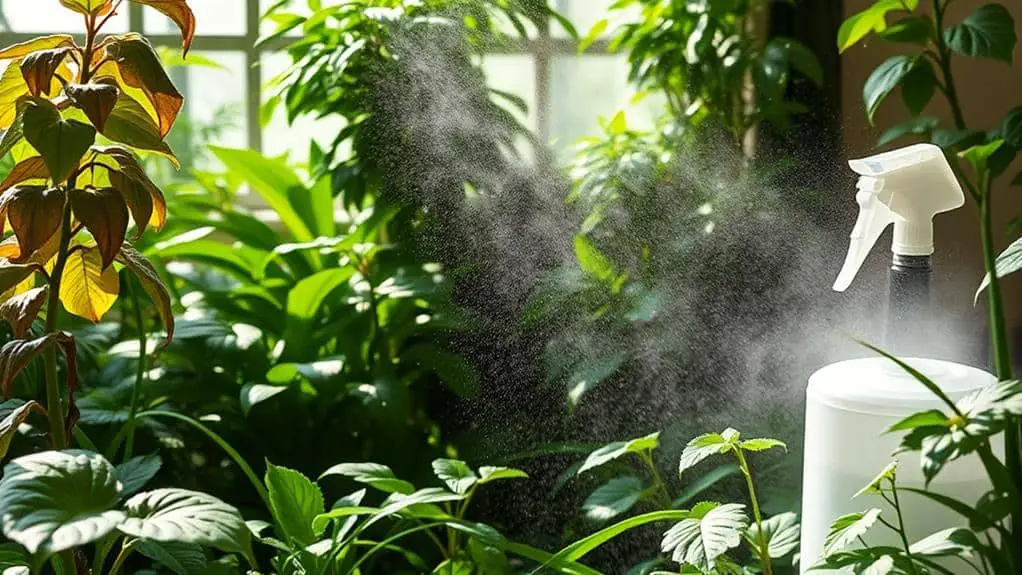
To help your plants cope with heat stress, increasing humidity can be a game-changer.
You can boost humidity by lightly watering overhead, grouping container plants together, or using misting systems.
Aim for a humidity level of around 40-60% to keep your plants happy during hot spells.
Benefits of Higher Humidity
Boosting humidity around your plants can considerably enhance their ability to cope with heat stress. By increasing humidity, you help maintain essential transpiration levels, keeping your plants cool and healthy.
Ideal humidity levels between 40-70% support plant health and reduce wilting.
- Improves transpiration: Guarantees better water balance and cooler leaf temperatures.
- Prevents wilting: Helps plants stay firm and vibrant during high temperatures.
- Supports photosynthesis: Keeps stomata open for better gas exchange.
- Creates a microenvironment: Grouping plants or using misting systems can benefit sensitive species.
- Enhances resilience: Especially vital for tropical plants that thrive in moist conditions.
Simple Humidity Boosting Methods
Elevate your plant care game by adopting simple humidity-boosting methods to help your green friends beat the heat. Lightly misting leaves in the early morning can temporarily raise humidity, easing heat stress. Use pebble trays beneath potted plants; as water evaporates, it increases surrounding humidity. Indoor humidifiers are fantastic for maintaining consistent humidity levels, especially for tropical plants. Lightly watering overhead can also help, but avoid wetting foliage during peak heat to prevent leaf scorch.
Here's how to boost humidity for your plants:
| Method | Benefit |
|---|---|
| Misting Leaves | Reduces transpiration rates |
| Pebble Trays | Raises humidity through evaporation |
| Indoor Humidifiers | Maintains higher humidity levels |
| Overhead Watering | Temporary humidity boost |
Boosting humidity helps your plants thrive during hot weather!
Grouping Plants for Humidity
Enhancing your plant care routine doesn't stop at increasing humidity through individual methods. Grouping your container plants can create a microclimate that retains more moisture, reducing heat stress.
When plants are close together, their leaves help trap humidity from transpiration, creating a more humid environment. Here are some practical tips:
- Cluster plants: Position your plants together to boost shared humidity.
- Water trays: Use trays filled with water and pebbles under your plants to enhance moisture through evaporation.
- Morning misting: Mist the leaves in the early morning to temporarily raise humidity.
- Monitor levels: Use a hygrometer to check humidity and adjust groupings as needed.
- Choose compatible plants: Group species that thrive in similar humidity conditions.
This method guarantees your plants stay healthy and stress-free.
Avoiding Planting or Transplanting
Planting or transplanting during high temperatures can put significant strain on young seedlings, as the warm soil harms their delicate root systems and impedes their establishment.
It's best to wait until cooler conditions, ideally below 80°F (27°C), to promote healthier growth and reduce transplant shock.
During heat waves, newly planted or transplanted plants are at greater risk of dehydration and wilting, needing more water to establish themselves.
Transplanting in extreme heat can force plants to focus on surviving rather than growing, which stunts their development and may cause long-term damage.
For better success, try planting or transplanting in the early morning or late evening when temperatures are milder, minimizing heat stress exposure.
Frequently Asked Questions
How to Tell if a Plant Is Heat Stressed?
To evaluate if a plant's heat-stressed, check for leaf rolling, wilting, dry edges, blossom drop, and ozone damage. Effective plant care and evaluating heat tolerance help manage these environmental factors and guarantee your plant's health.
Can a Plant Recover From Heat Stress?
Yes, a plant can recover from heat stress. Increase its heat tolerance with proper recovery methods like deep watering, providing shade, and mulching. Your plant's resilience will improve, showing new growth and better leaf condition.
What Are the Symptoms of Heat Injury in Plants?
You'll notice symptoms like leaf rolling and wilting when heat stress causes damage. Prevent issues by maintaining ideal temperatures and using shading techniques. Dry leaf edges and blossom drop are also indicators. Act quickly to protect your plants.
What Does Heat Damage Look Like on Plants?
You'll notice heat damage on plants through leaf discoloration, wilting foliage, and stunted growth. Leaves may turn brown or crispy, plants droop visibly, and growth slows markedly as the plant struggles to survive high temperatures.
Conclusion
So, if you notice any signs of heat stress in your plants, don't worry! You've got this. Start by giving them a deep watering, adding mulch, and providing some shade. Increase humidity if you can, and try to avoid planting or transplanting during extreme heat. By keeping an eye on your plants and taking these simple steps, you'll help them bounce back and thrive. Happy gardening, and remember, your plants are in good hands!

